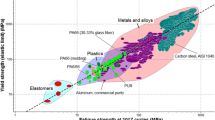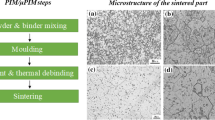Abstract
Replication processes for the manufacturing of micro/nano-structured components are characterized by a certain degree of precision and accuracy. The transcription loss, or replication fidelity, defines the geometrical and dimensional correspondence of micro/nano-structure from metal tool inserts into plastic patterned products. The employment of a vast spectrum of micro/nano-structured geometries calls for methodologies that can be used for the estimation of replication fidelity. This study presents a number of product fingerprints, which propose multiple ways to characterize micro/nano structures in replication technologies. Replication fidelity yielded values above 80% and up to 96% depending on the considered product fingerprints and their definition. Thereafter, a correlation of the product fingerprint with the process parameters was found to optimize the replication process. Measurement uncertainty accompanies the analysis of the product fingerprints, enabling a standardized, robust, and quantitative methodology for process learning, modeling, and optimization.













Similar content being viewed by others
References
Roeder M, Guenther T, Zimmermann A (2019) Review on fabrication technologies for optical mold inserts. Micromachines 10:1–25
Maghsoudi K, Jafari R, Momen G, Farzaneh M (2017) Micro-nanostructured polymer surfaces using injection molding: a review. Mater Today Commun 13:126–143
Packianather M, Griffiths C, Kadir W (2015) Micro injection moulding process parameter tuning. In: Procedia CIRP, pp 400–405
Baruffi F, Gülçür M, Calaon M et al (2019) Correlating nano-scale surface replication accuracy and cavity temperature in micro-injection moulding using in-line process control and high-speed thermal imaging. J Manuf Process 47:367–381
Calaon M, Hansen HN, Tosello G et al (2013) Microfluidic chip designs process optimization and dimensional quality control. Microsyst Technol 21:561–570
Vera J, Brulez A-C, Contraires E et al (2018) Factors influencing microinjection molding replication quality. J Micromech Microeng 28:015004
Rytka C, Kristiansen PM, Neyer A (2015) Iso- and variothermal injection compression moulding of polymer micro- and nanostructures for optical and medical applications. J Micromech Microeng 25:065008
Nagato K (2014) Injection compression molding of replica molds for nanoimprint lithography. Polymers 6(3):604–612
Sorgato M, Babenko M, Lucchetta G, Whiteside B (2017) Investigation of the influence of vacuum venting on mould surface temperature in micro injection moulding. Int J Adv Manuf Technol 88:547–555
Tosello G (2019) Product/process fingerprint in micro manufacturing. Micromachines 10(5):340
Brinksmeier E, Reese S, Klink A, Langenhorst L, Lübben T, Meinke M, Meyer D, Riemer O, Sölter J (2018) Underlying mechanisms for developing process signatures in manufacturing. Nanomanuf Metrol 1(4):193–208
Sealy MP, Liu ZY, Guo YB, Liu ZQ (2016) Energy based process signature for surface integrity in hard milling. J Mater Process Technol 238:284–289
Parenti P, Masato D, Sorgato M, Lucchetta AM (2017) Surface footprint in molds micromilling and effect on part demoldability in micro injection molding. J Manuf Process 29:160–174
Frerichs F, Meyer H, Strunk R, Kolkwitz B, Epp J (2018) Development of a process signature for manufacturing processes with thermal loads. Metall Mater Trans A Phys Metall Mater Sci 49(8):3419–3429
Eckert S (2019) Multi-cycle process signature of laser-induced thermochemical polishing. J Manuf Mater Process 3(4):90
Fang T, Jafari MA, Bakhadyrov I, Safari A, Danforth S, Langrana N (1998) On-line defect detection in layered manufacturing using process signature. Proc IEEE Int Conf Syst Man Cybern 5:4373–4378
Tosello G, Marinello F, Hansen HN (2012) Characterisation and analysis of microchannels and submicrometre surface roughness of injection moulded microfluidic systems using optical metrology. Plast Rubber Compos Macromol Eng 41(1):29–39
Calaon M, Tosello G, Garnaes J, Hansen HN (2017) Injection and injection-compression moulding replication capability for the production of polymer lab-on-a-chip with nano structures. J Micromech Microeng 27:105001
Christiansen AB, Clausen JS, Mortensen NA, Kristensen A (2014) Injection moulding antireflective nanostructures. Microelectron Eng 121:47–50
Regi F, Doest M, Loaldi D, Li D, Frisvad JR, Tosello G, Zhang Y (2019) Functionality characterization of injection moulded micro-structured surfaces. Precis Eng 60:594–601
Søgaard E, Andersen N K, Taboryski R, Smistrup K (2012) Injection molded superhydrophobic surfaces based on microlithography and black silicon processing. In: Technical proceedings of the 2012 NSTI nanotechnology conference and expo, pp 722–725
Loaldi D, Quagliotti D, Calaon M, Parenti P, Annoni M, Tosello G (2018) Manufacturing signatures of injection molding and injection compression molding for micro-structured polymer Fresnel lens production. Micromachines 9(12):653
Giannekas N, Zhang Y, Tosello G (2018) Investigation on product and process fingerprints for integrated quality assurance in injection molding of microstructure biochips. J Manuf Mater Process 2:79
Zhang Y, Basso A, Christensen SE, Pedersen DB, Staal L, Valler P, Hansen HN (2020) Characterization of near-zero pressure powder injection moulding with sacrificial mould by using fingerprint geometries. Cirp Ann 69(1):185–188
Dundar Arisoy F, Czolkos I, Johansson A, Nielsen T, Watkins JJ (2020) Low-cost, durable master molds for thermal-NIL, UV-NIL, and injection molding. Nanotechnology 31(1):15302
Baruffi F, Calaon M, Tosello G (2018) Micro-injection moulding in-line quality assurance based on product and process fingerprints. Micromachines 2018(9):293
Giannekas N, Kristiansen PM, Zhang Y, Tosello G (2018) Investigation of product and process fingerprints for fast quality assurance in injection molding of micro-structured components. Micromachines 9(12):661
Loaldi D (2020) Integration of micro and nano structures on injection moulded devices. Ph.D. Thesis, Department of Mechanical Engineering, Technical University of Denmark, Kgs. Lyngby, Denmark.
Autodesk Moldflow® Insight (2017) Material database, Autodesk Inc, San Rafael, CA, USA
JCGM 100 (2008) Evaluation of measurement data—guide to the expression of uncertainty in measurement (GUM).
ISO 15530-3 (2011) Geometrical product specification (GPS)-coordinate measuring machine (CMM): techniques for determining the uncertainty of measurement. (ISO 15530-3:2011). International Organization for Standardization, Geneva
ISO 251078-70 (2014) Geometrical product specification (GPS)-Surface texture: Areal—Part 70: Material measures. (ISO 25178-70:2014). International Organization for Standardization, Geneva
Yang Y, Pan Y, Ping G (2017) Structural coloration of metallic surfaces with micro/nano-structures induced by elliptical vibration texturing. Appl Surf Sci 402:400–409
Montgomery DC (2012) Design and analysis of experiments, 8th edition, Wiley, ISBN: 978-1-118-09793-9
Acknowledgements
This research work was undertaken in the context of the research projects PROSURF and MADE DIGITAL. The PROSURF project (“Surface Specifications and Process Chains for Functional Surfaces”, http://www.prosurf-project.eu/) is funded by the HORIZON 2020 program (Project ID: 767589) of the European Commission. MADE DIGITAL (Project ID: 6151-00006B), Manufacturing Academy of Denmark (http://en.made.dk/), Work Package WP3 “Digital manufacturing processes”, is funded by Innovation Fund Denmark (https://innovationsfonden.dk/en).
Author information
Authors and Affiliations
Corresponding author
Ethics declarations
Conflict of interest
On behalf of all authors, the corresponding author states that there are no conflicts of interest.
Rights and permissions
About this article
Cite this article
Loaldi, D., Regi, F., Li, D. et al. Product Fingerprints for the Evaluation of Tool/Polymer Replication Quality in Injection Molding at the Micro/Nano Scale. Nanomanuf Metrol 4, 278–288 (2021). https://doi.org/10.1007/s41871-021-00105-7
Received:
Revised:
Accepted:
Published:
Issue Date:
DOI: https://doi.org/10.1007/s41871-021-00105-7




